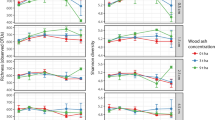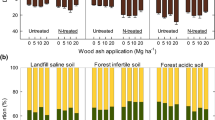Abstract
Wood ash was applied to a forest ecosystem with the aim to recycle nutrients taken from the forest and to mitigate the negative effects of intensive harvesting. After two years, the application of 8,000 kg ha−1 of wood ash increased soil exchangeable Ca and Mg. Similarly, an increase in Ca and Mg in the Norway spruce fine roots was recorded, leading to significant linear correlations between soil and root Ca and soil and root Mg. In contrast to these macronutrients, the micronutrients Fe and Zn and the toxic element Al decreased in the soil exchangeable fraction with the addition of wood ash, but not in the fine roots. Only Mn decreased in soil and in fine roots leading to a significant linear correlation between soil and root Mn. In soil, as well as in fine roots, strong positive correlations were found between the elements Ca and Mg and between Fe and Al. This indicates that the uptake of Mg resembles that of Ca and that of Al that of Fe. With the wood ash application, the pH increased from 3.2 to 4.8, the base saturation from 30% to 86%, the molar basic cations/Al ratio (BC/Al) of the soil solution from 1.5 to 5.5, and the molar Ca/Al ratio of the fine roots from 1.3 to 3.7. Overall, all below-ground indicators of soil acidification responded positively to the wood ash application within two years. Nitrate concentrations increased only slightly in the soil solution at a soil depth of 75–80 cm, and no signs of increased heavy metal concentrations in the soils or in the fine roots were apparent. This suggests that the recycling of wood ash could be an integral part of sustainable forest management because it closes the nutrient cycle and reverses soil acidification.
Similar content being viewed by others
References
Arvidsson H and Lundkvist H 2002 Needle chemistry in young Norway spruce stands after application of crushed wood ash. Plant Soil 238, 159–174.
Arvidsson H and Lundkvist H 2003 Effects of crushed wood ash on soil chemistry in young Norway spruce stands. For. Ecol. Manage. 176, 121–132.
Badoux E 1983 Ertragstafeln für die Fichte in der Schweiz. EAFV, Birmensdorf, Switzerland.
Bakker M R 1999 Fine-root parameters as indicators of sustainability of forest ecosystems. For. Ecol. Manage. 122, 7–16.
Blaser P, Zysset M, Zimmermann S and Luster J 1999 Soil acidification in southern Switzerland between 1987 and 1997: A case study based on the critical load concept. Environ. Sci. Technol. 33, 2383–2389.
Brunner I, Rigling D, Egli S and Blaser P 1999 Response of Norway spruce seedlings in relation to chemical properties of forest soils. For. Ecol. Manage. 116, 71–81.
Brunner I, Brodbeck S and Walthert L 2002 Fine root chemistry, starch concentration, and ‘vitality’ of subalpine conifer forests in relation to soil pH. For. Ecol. Manage. 165, 75–84.
Bundt M, Widmer F, Pesaro M, Zeyer J and Blaser P 2001a Preferential flow paths: biological ‘hot spots’ in soils. Soil Biol. Biochem. 33, 729–738.
Bundt M, Zimmermann S, Blaser P and Hagedorn F 2001b Sorption and transport of metals in preferential flow paths and soil matrix after the addition of wood ash. Eur. J. Soil Sci. 52, 423–431.
Cronan C and Grigal D F 1995 Use of calcium/aluminum ratios as indicators of stress in forest ecosystems. J. Environ. Qual. 24, 209–226.
De Vries W, Vel E, Reinds G J, Deelstra H, Klap J M, Leeters E E J M, Hendriks C M A, Kerkvoorden M, Landmann G, Herkendell J, Haussmann T and Erisman J W 2003 Intensive monitoring of forest ecosystems in Europe. 1. Objectives, set-up and evaluation strategy. For. Ecol. Manage. 174, 77–95.
Driscoll C T, Lawrence G B, Bulger A J, Butler T J, Cronan C S, Eagar C, Lambert K F, Likens G E, Stoddard J L and Weathers K C 2001 Acidic deposition in the northeastern United States: Sources and inputs, ecosystem effects, and management strategies. BioScience 51, 180–198.
Ellenberg H and Klötzli F 1972 Waldgesellschaften und Waldstandorte. Mitt. Eidg. Anst. Forstl. Versuchswes. 48, 587–930.
Eriksson H M 1998 Short-term effects of granulated wood ash on forest soil chemistry in SW and NE Sweden. Scand. J. For. Res. Suppl. 2, 43–55.
Fowler D, Cape N, Coyle M, Flecaard C, Kuylenstierna J, Hicks K, Derwent D, Johnson C and Stevenson D 1999 The global exposure of forests to air pollution. Wat. Air Soil Pollut. 116, 5–32.
Frühwald A 1995 LCA - a challenge for forestry and forest products industry.In Life-cycle analysis - A challenge for forestry and forest industry. Eds. A Frühwald and B Solberg. pp. 9–14. EFIProceeding No. 8, Joensuu, Finland.
Genenger M, Jaeggi M, Siegwolf R, Chalot M, Frossard E and Brunner I 2003a Rapid15N uptake and metabolism in fine roots of Norway spruce. Trees 17, 144–152.
Genenger M, Zimmermann S, Frossard E and Brunner I 2003b The effects of fertiliser or wood ash on nitrate reductase activity in Norway spruce fine roots. For. Ecol. Manage. 175, 413–423.
Genenger M, Zimmermann S, Hallenbarter D, Landolt W, Frossard E and Brunner I 2003c Fine root growth and element concentrations of Norway spruce as affected by wood ash and liquid fertilisation. Plant Soil 255, 253–264.
Hahn G and Marschner H 1998 Cation concentration of short roots of Norway spruce as affected by acid irrigation and liming. Plant Soil 199, 23–27.
Hallenbarter D, Landolt W, Bucher J B and Schütz J P 2002 Effects of wood ash and liquid fertilization on the nutritional status and growth of Norway, spruce (Picea abies (L.) Karst.). Forstwiss. Centralbl. 121, 240–249.
Heim A, Luster J, Brunner I, Frey B and Frossard E 1999 Effects of aluminium treatment on Norway spruce roots: Aluminium binding forms, element distribution, and release of organic acids. Plant Soil 216, 103–116.
Hettelingh J-P and de Vries W 1992 Mapping Vademecum. Report No. 259101002, National Institute of Public Health and Environmental Protection, Bilthoven.
Horst W H 1995 The role of the apoplast in aluminum toxicity and resistance of higher plants: A review. Z. Pflanzenern. Bodenk. 158, 419–428.
Khanna P K and Madeira M 2002 Sustainability of forest soils. For. Ecol. Manage. 172, 1–2.
Lodenius M 2003 Cadmium concentrations in a boreal forest ecosystem after application of wood ash. Bull. Environ. Contam. Toxicol. 71, 776–781.
Ludwig B, Rumpf S, Mindrup M, Meiwes K-J and Khanna P K 2002 Effects of lime and wood ash on soil-solution chemistry, soil chemistry and nutritional status of a pine stand in Northern Germany. Scand. J. For. Res. 17, 225–237.
Marschner H 1995 Mineral nutrition of higher plants. Academic Press, London.
Noger D, Felber H and Pletscher E 1996 Verwertung und Beseitigung von Holzaschen. Schriftenreihe Umwelt Nr. 269, BUWAL, Bern, Switzerland.
Olsson B A, Bengtsson J and Lundkvist H 1996 Effects of different forest harvest intensities on the pools of exchangeable cations in coniferous forest soils. For. Ecol. Manage. 84, 135–147.
Palmer S M and Driscoll C T 2002 Acidic deposition - Decline in mobilization of toxic aluminium. Nature 417, 242–243.
Rodhe H, Dentener F and Schulz M 2002 The global distribution of acidifying wet deposition. Environ. Sci. Technol. 36, 4382–4388.
Rumpf S, Ludwig B and Mindrup M 2001 Effect of wood ash on soil chemistry of a pine stand in Northern Germany. J. Plant Nutr. Soil Sci. 164, 569–575.
Sharpe W E 2002 Acid deposition explains sugar maple decline in the east. Bioscience 52, 4–5.
Sverdrup H and Warfvinge P 1993 The effect of soil acidification on the growth of trees, grass, herbs as expressed by the (Ca+Mg+K)/Al ratio. Rep. in Ecology and Environmental Engineering 2. Lund University, Department of Chemical Engineering II, Lund.
Werner F, Althaus H-J and Richter K 2002 Post-consumer wood in environmental decision-support tools. Schweiz. Z. Forstwes. 153, 97–106.
Zimmermann S and Frey B 2002 Soil respiration and microbial properties in an acid forest soil: effects of wood ash. Soil Biol. Biochem. 34, 1727–1737.
Zysset M, Brunner I, Frey B and Blaser P 1996 Response of European chestnut to varying calcium/aluminum ratios. J. Environ. Qual. 25, 702–708.
Author information
Authors and Affiliations
Corresponding author
Rights and permissions
About this article
Cite this article
Brunner, I., Zimmermann, S., Zingg, A. et al. Wood-ash recycling affects forest soil and tree fine-root chemistry and reverses soil acidification. Plant Soil 267, 61–71 (2004). https://doi.org/10.1007/s11104-005-4291-z
Received:
Accepted:
Issue Date:
DOI: https://doi.org/10.1007/s11104-005-4291-z




